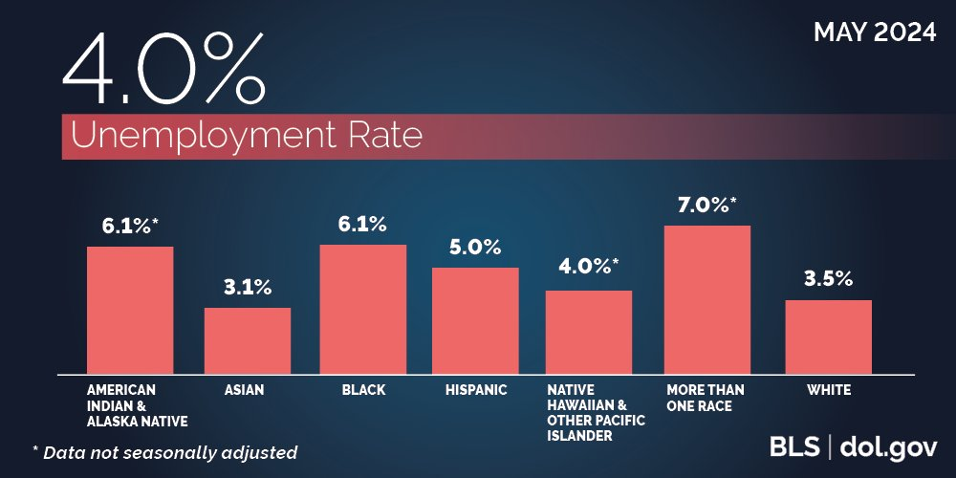Numbers Explain Presidential Election Issue Pitting Claims of Strong Economy vs Criticisms of Rising Unemployment & Stubborn Inflation

Despite the Federal Reserve’s hope to restrain the U.S. economy through high-interest rates for borrowed federal money in the hopes of reducing still stubborn inflation, job growth in the U.S. economy, against all predictions, surged dramatically yet again in May.
Wall Street analysts were left stunned and embarrassed by their much more bearish and wildly erroneous job growth predictions of somewhere between 170,000 to 200,000. Hopes for a lowering of interest rates in calendar 2024 were reduced to the optimists predicting one rate reduction this calendar year (down from 6 the market predicted only five months ago), perhaps in December. Pessimists even feared a further Federal Reserve rate hike (not reduction) early in 2025 if the stubborn inflation rate does not start trending steadily down (meaning step-downs 6 months in a row) to 2% annualized. As of May 15, the inflation rate in the United States was 3.4%, equal to the 2023 annualized inflation rate.
Job growth increased in May with the economy adding a whopping 272,000 jobs. Even so, the unemployment rate nonetheless rose (to 4.0 percent from 3.9%) as both the short-term and long-term unemployment lists grew in May, the U.S. Bureau of Labor Statistics (”BLS”) stated in its May 2024 Employment Situation report. Those figures for April were 165,000 new jobs (adjusted) and 3.9 percent unemployment. The BLS noted that the 272k figure was higher than the average monthly gain of 232k over the prior 12 months signaling an economy in transition from old jobs to new jobs.
NOTE: Many in Silicon Valley are likening the emergence of artificial intelligence technology as akin in importance to the Industrial Revolution. Really! To many in Silicon Valley right now, it also feels eerily like late 1993 when the “Internet Bubble” silently began (people in the Valley could feel something was happening with more business inventions popping up daily beyond one’s ability to catalog them all, but they did not initially understand that a digitally-connected Internet world of communication and commerce was emerging). Only some of us at that time had something called e-mail service by the mid-1990s. (Reality check: Netscape was incorporated in April 1994 and was the first company to exploit the World Wide Web by delivering a superior tool we now call a “web browser” …and launching an entirely new industry, and many collateral industries. Bill Clinton was the first President to use e-mail service…wait for it…in 1994).
In May, employment rose in health care (68k jobs); government employment (43k jobs; leisure and hospitality (42k jobs); professional, scientific, and technical services (32k jobs); social assistance (15k jobs); and retail trade (13k jobs).
The labor force participation rate was 62.7 percent in May, down a smidge from 62.5 percent in April. May’s employment-population ratio was 60.1 percent, down slightly from April’s 60.2 percent.
The number of short-term unemployed persons was 6,649,000 in May, up by 157,000 from the 6,492,000 figure in April. The number of long-term unemployed (those jobless for 27 weeks or more) was 1,350,000 (20.7 percent of the total unemployed), which was up by 100,000 from April’s figure of 1,250,000 (19.6 percent of the total unemployed).
By comparison, in May 2023, the unemployment rate was 3.7 percent, the number of short-term unemployed was 6,117,000, and the number of long-term unemployed was 1,132,000 (18.9 percent of the total unemployed).
EDITOR’s NOTE: Here you see the foundations of the political unrest. Despite a growing (raging) economy, many Americans are feeling economic pain (and sometimes disproportionally: see Black unemployment report, as well as Individuals with Disabilities for an even greater increase below) both from unemployment and the erosion of their savings due to inflation, and for those working, to their earnings as wage increases in 2024 have been between 3% and 3.5%, barely keeping up or falling behind a stubborn and continuing inflation rate of 3.4%.
Major Worker Groups
The BLS/DOL charts below illustrate the numbers by race and ethnicity (data for some groups not seasonally adjusted). African Americans were the most heavily impacted racial group in May while Hawaiians, women, and Veterans improved their employment statuses:
Our table below compares the major worker groups’ numbers from the last three months of available data:
|
The Employment Situation – May 2024 |
||||
| Unemployment Rate |
March 2024 |
April 2024 |
May 2024 | Feb 2020 Pre-Pandemic |
| National (Seasonally adjusted) |
3.8% | 3.9% | 4.0% | 3.5% |
| White | 3.4% | 3.5% | 3.5% | 3.0% |
| Black | 6.4% | 5.6% | 6.1% | 6.0% |
| Asian | 2.5% | 2.8% | 3.1% | 2.5% |
| Hispanic (Seasonally adjusted) |
4.5% | 4.8% | 5.0% | 4.4% |
| Native Hawaiians & Other Pacific Islanders | 4.5% | 6.5% | 4.0% | 2.7% |
| Two or More Races (Not seasonally adjusted) |
7.5% | 6.4% | 7.0% | 6.1% |
| Men (20+) | 3.3% | 3.6% | 3.8% | 3.2% |
| Women (20+) (Seasonally adjusted) |
3.6% | 3.5% | 3.4% | 3.1% |
| Veteran (Not seasonally adjusted) |
3.0% | 3.1% | 2.1% | 3.7% |
| Individuals with Disabilities (Not seasonally adjusted) |
8.6% | 6.3% | 7.5% | 7.8% |
Acting Secretary of Labor Su’s comments (linked in full, below) were upbeat about the strong economy. Acting Secretary Su, however, predictably ignored the bad news about the increasing unemployment rolls and inflation eroding savings, earnings, and wage increases often not keeping pace with inflation causing their buying power to “go backwards”:
“May was yet another good month for the American labor market. The Biden-Harris administration will continue to do all that we can to ensure that workers have opportunity and access to good jobs — the kind where workers aren’t just getting by but getting ahead.”
See Also:
- BLS has additional, interactive graphs available here
- President Biden’s remarks
- Acting Secretary of Labor Julie Su’s statement
- USDOL video short illustrating the report
- White House Counsel of Economic Advisers’ blog
SUBSCRIBE.
Subscribe to receive alerts, news and updates on all things related to OFCCP compliance as it applies to federal contractors.
OFCCP Compliance Text Alerts
Get OFCCP compliance alerts on your cell phone. Text the word compliance to 18668693326 and confirm your subscription. Provider message and data rates may apply.

